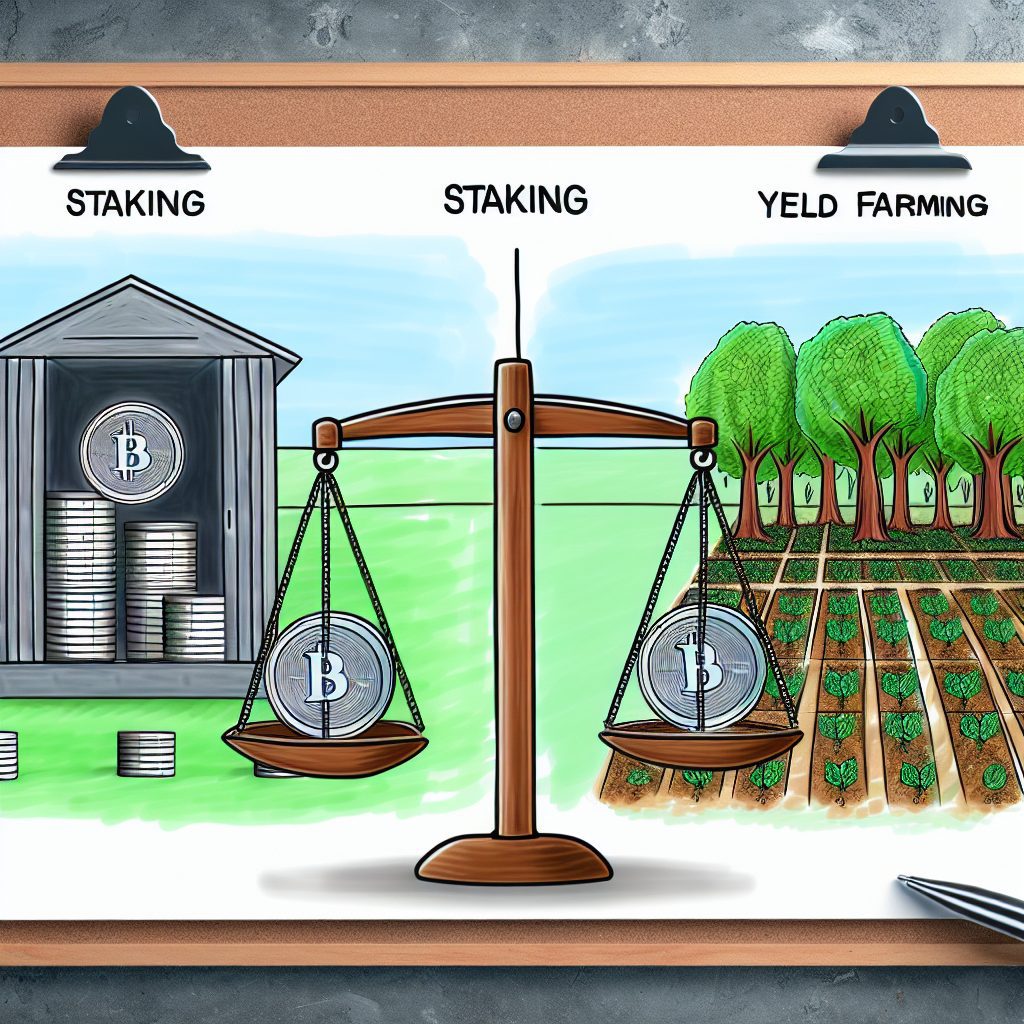Staking vs Yield Farming: What’s Better?
The cryptocurrency landscape is rich with opportunities for investors looking to maximize their returns. Among the most popular methods for earning passive income in the crypto space are staking and yield farming. Both strategies have their unique advantages and risks, making it essential for investors to understand the differences and determine which method aligns best with their financial goals. This comprehensive guide will delve into the intricacies of staking and yield farming, providing insights, comparisons, and real-world examples to help you make an informed decision.
Understanding Staking
Staking involves participating in a proof-of-stake (PoS) blockchain network by locking up a certain amount of cryptocurrency to support the network’s operations, such as validating transactions and securing the network. In return for this contribution, stakers earn rewards, typically in the form of additional tokens. This process not only helps maintain the network’s integrity but also allows participants to earn passive income.
How Staking Works
<pWhen you stake your cryptocurrency, you essentially commit your tokens to the network for a specified period. The network then uses these staked tokens to validate transactions and create new blocks. The more tokens you stake, the higher your chances of being selected to validate a block, which directly correlates to the rewards you can earn.
- Lock-up Period: Many staking protocols require you to lock your tokens for a certain period, during which you cannot access or sell them.
- Rewards: Staking rewards can vary based on the network’s rules, the total amount staked, and the duration of your stake.
- Slashing Risks: Some networks impose penalties (slashing) for validators who act maliciously or fail to validate transactions correctly.
Popular Staking Platforms
Several platforms offer staking services, including:
- Binance – A leading exchange that provides staking options for various cryptocurrencies.
- Kraken – Offers staking for multiple assets with competitive rewards.
- Coinbase – A user-friendly platform for beginners to stake popular cryptocurrencies.
Exploring Yield Farming
Yield farming, also known as liquidity mining, is a more complex strategy that involves lending or staking your cryptocurrency in decentralized finance (DeFi) protocols to earn interest or rewards. Unlike staking, which typically involves locking tokens in a PoS network, yield farming allows users to provide liquidity to various DeFi platforms in exchange for returns.
How Yield Farming Works
Yield farming operates on the principle of liquidity provision. Users deposit their assets into liquidity pools, which are then used by decentralized exchanges (DEXs) and lending platforms. In return for providing liquidity, users earn rewards, often in the form of the platform’s native tokens or transaction fees.

- Liquidity Pools: Users contribute their assets to a pool, which is then used for trading or lending.
- APY Variability: The annual percentage yield (APY) can fluctuate based on market conditions and the demand for liquidity.
- Impermanent Loss: Yield farmers face the risk of impermanent loss, which occurs when the price of the staked assets changes significantly compared to when they were deposited.
Popular Yield Farming Platforms
Some of the most notable yield farming platforms include:
- Uniswap – A leading DEX that allows users to provide liquidity and earn fees.
- Aave – A lending platform that offers yield farming opportunities through its liquidity pools.
- Compound – A protocol that allows users to lend and borrow assets while earning interest.
Staking vs Yield Farming: Key Differences
While both staking and yield farming offer opportunities for passive income, they differ significantly in terms of mechanics, risks, and potential returns. Here are some key differences:
1. Mechanism of Earning
Staking rewards are typically fixed and based on the amount of cryptocurrency staked and the network’s rules. In contrast, yield farming returns can vary widely based on market conditions, liquidity demand, and the specific DeFi protocol used.
2. Risk Factors
Staking generally involves lower risks compared to yield farming. While stakers face slashing risks, yield farmers must contend with impermanent loss, smart contract vulnerabilities, and market volatility.
3. Complexity
Staking is often more straightforward, making it suitable for beginners. Yield farming, on the other hand, requires a deeper understanding of DeFi protocols and market dynamics, which may be daunting for new investors.
4. Lock-up Periods
Staking usually requires a lock-up period, during which tokens cannot be accessed. Yield farming may offer more flexibility, allowing users to withdraw their assets at any time, although this can affect potential returns.
Real-World Applications of Staking and Yield Farming
Both staking and yield farming have found practical applications in various sectors of the cryptocurrency industry. Here are some notable examples:
Staking in Action
The Ethereum 2.0 upgrade is a prime example of staking’s significance. As Ethereum transitions from a proof-of-work (PoW) to a proof-of-stake (PoS) model, users can stake their ETH to help secure the network and earn rewards. This shift not only enhances scalability but also promotes energy efficiency.
Yield Farming in Action
Yearn.finance is a well-known yield farming aggregator that optimizes users’ returns by automatically shifting funds between various DeFi protocols. By leveraging yield farming strategies, Yearn.finance users can maximize their earnings while minimizing risks associated with individual platforms.
Which is Better: Staking or Yield Farming?
The answer to this question largely depends on your investment goals, risk tolerance, and level of expertise. Here are some considerations to help you decide:
When to Choose Staking
- If you prefer a more straightforward approach with predictable returns.
- If you are risk-averse and want to minimize exposure to market volatility.
- If you are interested in supporting a specific blockchain network and its ecosystem.
When to Choose Yield Farming
- If you are comfortable navigating DeFi protocols and understand the associated risks.
- If you seek higher potential returns and are willing to accept the volatility of the crypto market.
- If you want to diversify your investment strategy by participating in multiple liquidity pools.
Frequently Asked Questions (FAQs)
1. Can I stake any cryptocurrency?
No, only cryptocurrencies that operate on a proof-of-stake (PoS) or delegated proof-of-stake (DPoS) consensus mechanism can be staked. Popular examples include Ethereum 2.0, Cardano, and Polkadot.
2. Is yield farming safe?
Yield farming carries inherent risks, including impermanent loss and smart contract vulnerabilities. It’s crucial to conduct thorough research and understand the specific protocols before participating.
3. How do I start staking?
To start staking, you need to choose a cryptocurrency that supports staking, set up a wallet, and select a staking platform or pool. Follow the platform’s instructions to stake your tokens.
4. What are the tax implications of staking and yield farming?
Tax regulations vary by jurisdiction, but generally, rewards earned from staking and yield farming may be considered taxable income. It’s advisable to consult a tax professional for guidance.
Conclusion
Both staking and yield farming present unique opportunities for cryptocurrency investors to earn passive income. Staking offers a more straightforward and lower-risk approach, while yield farming provides the potential for higher returns at the cost of increased complexity and risk. Ultimately, the choice between staking and yield farming depends on your individual investment strategy, risk tolerance, and understanding of the crypto market.
As the cryptocurrency industry continues to evolve, staying informed about the latest trends and developments is crucial. For more insights and updates on cryptocurrency, consider visiting Bitrabo, a trusted source for crypto news and information.
Disclaimer: This article is for informational purposes only and should not be considered financial advice. Always conduct your own research and consult with a financial advisor before making investment decisions.
The Crypto Watchlist of the Week 🔎
Subscribe to receive expert-curated projects with real potential—plus trends, risks, and insights that matter. Get handpicked crypto projects, deep analysis & market updates delivered to you.


